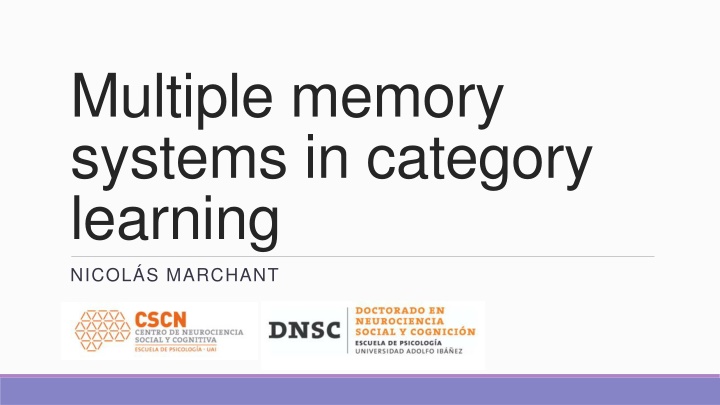
Category Learning in Cognitive Neuroscience
Explore the concept of category learning and its implications in cognitive neuroscience, including classical theories, multi-modal approaches, and different types of category learning tasks like rule-based and information integration tasks.
Download Presentation

Please find below an Image/Link to download the presentation.
The content on the website is provided AS IS for your information and personal use only. It may not be sold, licensed, or shared on other websites without obtaining consent from the author. If you encounter any issues during the download, it is possible that the publisher has removed the file from their server.
You are allowed to download the files provided on this website for personal or commercial use, subject to the condition that they are used lawfully. All files are the property of their respective owners.
The content on the website is provided AS IS for your information and personal use only. It may not be sold, licensed, or shared on other websites without obtaining consent from the author.
E N D
Presentation Transcript
Multiple memory systems in category learning NICOL S MARCHANT
What is category learning? Category learning is the ability of an organism to learn to classify an item or events into groups (Seger & Braunlich, 2015). The grouping experience come along with a wide range of phenomena from the most concrete/literal (e.g., color) to the more abstract (e.g., peace, love, democracy). (Seger and Miller, 2010). In cognitive neuroscience, a wide variety of task are performed under the category learning paradigm.
Classical theories Prototype: An abstract representation is formed by computing a central tendency from all features of previous exemplars (Posner & Keele, 1968; Rosch & Mervis, 1975). Exemplar: People represent their categories by storing every individual exemplar in memory through stimulus similarity (Medin & Schaffer, 1978; Nosofsky, 1984; 1986). Decision bound: Due to the trial-by-trial variability in perceptual information, subjects learn to assign responses into different regions of the perceptual space (Ashby & Gott, 1988; Maddox & Ashby, 1993). Zeithamova, et al., (2019).
Multi-modal approach COVIS Theory: Declarative system: Procedural system: Ashby & Valentin, (2017).
Category learning task: Rule-based Rule-based (RB) task are those where subjects can easily verbalize the decision criteria. Category rules are learning via explicit reasoning (conscious activation) (Ashby, et al., 1998) RB task correlates with declarative memory systems (e.g., working memory, episodic memory and semantic memory). Ashby & Valentin, (2018). Patients with PFC damage have working memory impairments and also RB category learning deficits (Ashby & O Brien, 2005). Ashby & O Brien, (2005).
Category learning task: Information integration Information integration (II) task are those were perfect accuracy can only be achieved if two or more dimensions are integrated at some pre-decisional stage. II task are impossible or very difficult to verbalize (Ashby & Maddox, 2005). II task correlates with procedural memory (e.g., skills that are acquired through practice) (Ashby & O Brien, 2005). Ashby & O Brien, (2005). Procedural memory is mediated by the basal ganglia (BG). Impairments in BG (e.g., Parkinson disease and Huntington s disease) causes deficits in II task. (Ashby & O Brien, 2005; Seger & Miller, 2010) Ashby & Valentin, (2018).
Category learning task: Probabilistic The weather prediction task (WPT) combines probabilistic feedback with stimuli that vary on binary-valued dimensions (Knowlton, Squire & Gluck, 1994). WPT correlates with the medial temporal lobes (hippocampus) and the basal ganglia (Ashby & Maddox, 2005; Seger & Braunlich, 2015). But this is an ongoing debate. Extended training shows deficit in amnesiac patients (Ashby & Maddox, 2005). Seger & Braunlich, (2015).
Category learning task: Prototype distortion In prototype distortion (PD) task, the category exemplar are created by randomly distorting a single category prototype (Ashby & Maddox, 2005). PD typical procedures: A, not A; A, B; Inference(Ell, et al., 2017). Ashby & O Brien, (2005).
Category learning task: Prototype distortion PD correlates with the Perceptual memory Representation System (PRS) that occurs within the occipital cortex (Ashby & O Brien, 2005). Evidence is in favor with the A, not A. Parkinson disease, schizophrenia, Alzheimer disease, shows normal A, not A. Amnesiac patients show normal A, not A but impaired A,B (Casale & Ashby, 2008). Zeithamova, Maddox & Schnyer, (2008). Seger & Braunlich, (2015).
Prototype distortion and selective attention Since Shepard, et al., (1961) selective attention is crucial in categorization environments. Subjects learn how to allocate attention in order to improve performance in a categorization task (Nosofsky, 1984; Kruschke, 1992). Rehder & Hoffman (2005) evidenced the used of eye-tracker in selective attention, favoring the exemplar theory. Inference learning promotes a better category generalization, because promotes the knowledge of the internal category structure (Hoffman & Rehder, 2010) Hoffman & Rehder, (2010).
Current experiment The proposed experiment combines an PD task with the WPT. Family Z: Family M: We elaborated two prototypical binary- valued ceremonial symbols (e.g., Hoffman & Rehder, 2010). With a total of 8 exemplars. We manipulated feature probability by logistic regression. Probabilistic feedback enhance feature correlations (Little & Lewandowski, 2009).
Current experiment Experiment is divided by training phase (3 blocks, 80 trials each) and a transfer phase (8 trials with a rating scale). By implementing individualized regression on rating scale (Rehder & Hastie, 2001; Puebla & Chaigneau, 2014). We could predict if the participants have learnt to allocate attention throughout learning. Thus, promoting a top-down processing on classification by the bottom-up activation of the perceived internal category structure.
Future directions Implement the experimental protocol using eye-tracker: Eye fixation on ROI Saccades Between-subject design with different attentional weight on features. Cognitive modeling on performance (promoting fits like ALCOVE) Implement using EEG: Feedback related negativity (Feedback discounting). Source reconstruction on medial temporal lobe, occipital cortex and the PFC. Implement real world categories.
